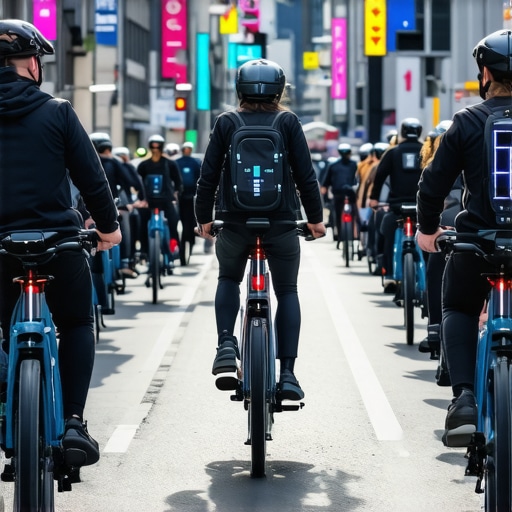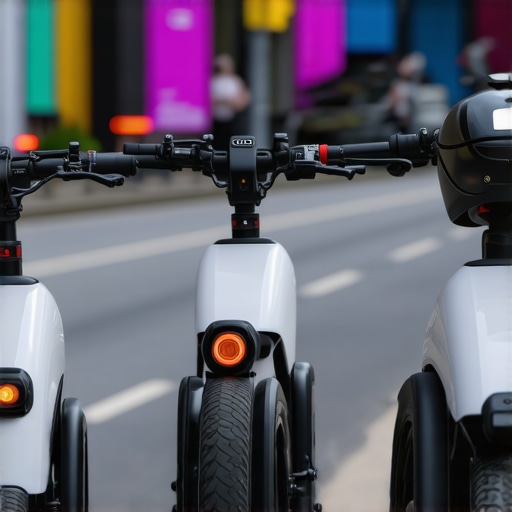My First Encounter with the Future of Urban Mobility
Last year, I found myself stuck in a typical city traffic jam, pondering how I could make my daily commute more efficient and eco-friendly. That moment sparked my curiosity about the emerging wave of electric bikes and innovative commuter gadgets set to revolutionize 2025 urban mobility. Since then, I’ve been diving deep into the latest tech and sharing my insights with fellow city dwellers eager to embrace smarter commuting options.
Why E-Bikes Are Becoming My Favorite City Companion
As I started exploring different e-bikes, I realized how much they could transform urban travel. Lightweight, powerful, and eco-conscious, these electric bicycles offer a perfect blend of convenience and sustainability. I personally tested models like the best e-bikes for 2025 and was amazed at their range and ease of use. Plus, with the rise of smart features, many e-bikes now integrate GPS, fitness tracking, and even anti-theft security, making them more than just a ride—they’re a smart travel partner.
Gadgets That Make Commuting Smarter and Safer
Beyond the bike itself, I’ve been captivated by gadgets that enhance safety and convenience. The new smart helmets, for example, are a game-changer. They come equipped with Bluetooth communication, crash sensors, and augmented reality displays—features I wish I had when I started cycling more seriously. To get a sense of what’s coming in 2025, I recommend checking out the top smart helmet features for 2025. They are truly pioneering the ride-tech revolution.
What Makes These Gadgets Stand Out in the Crowd?
What sets these gadgets apart is their focus on user experience and safety. Imagine riding through the city, knowing your helmet can detect a potential crash and alert emergency services automatically—this is not science fiction anymore. I’ve read reports that such innovations are becoming mainstream, which reassures me about the future of urban commuting. The combination of electric bikes and smart gadgets is shaping a more connected, efficient, and safe city life.
Ever Wondered How These Technologies Will Impact Our Daily Commutes?
Considering the rapid pace of innovation, I believe these advancements will significantly reduce commute times and environmental impact. For instance, integrating ride tech with public transit apps can streamline multi-modal travel, making the entire journey seamless. I encourage you to explore further and see how these innovations might fit into your routine. Feel free to share your thoughts or experiences in the comments—I love hearing how others are embracing this mobility revolution!
As I continue my journey into 2025’s urban mobility scene, I stay updated with authoritative sources like U.S. Department of Transportation, which emphasizes the importance of sustainable and intelligent transit solutions. It’s an exciting time, and I’m thrilled to be part of this movement toward smarter, greener cities.
How Will Advanced Ride Tech Transform Urban Commuting in the Near Future?
As the urban landscape evolves, so does the technology that shapes our daily journeys. The convergence of e-bike innovation and smart commuter gadgets is creating a transformative effect, promising not only enhanced convenience but also a safer, more sustainable city environment. Experts predict that by 2025, these advancements will be deeply integrated into our routines, redefining what it means to commute efficiently.
One of the most exciting developments is the integration of **AI-powered safety features** within smart helmets and bikes. These devices can analyze real-time data—such as traffic conditions, rider behavior, and environmental factors—to predict and prevent potential accidents. For example, a helmet equipped with crash sensors and AI algorithms can detect an imminent collision and alert emergency services automatically, significantly reducing response times and improving rider safety. To explore the latest innovations in this space, check out the best ride tech smart helmet innovations for 2025.
The Practical Impact of Smart Tech on Daily Commutes
In practical terms, these technologies will streamline multi-modal transportation, making it easier to combine e-bikes with public transit systems. Imagine an app that not only suggests the fastest route but also adjusts in real-time based on traffic congestion, weather, and personal preferences. This level of integration can dramatically cut down commute times, reduce congestion, and lower emissions—key goals outlined by urban planners and environmental advocates alike. For a comprehensive guide to the gadgets leading this revolution, visit best e-bikes and commuter gadgets in 2025.
What Are the Challenges Behind Rapid Adoption of Ride Tech in Cities?
While the potential is immense, several hurdles remain. Regulatory frameworks need to catch up with technological advancements, especially concerning safety standards and data privacy. Infrastructure also plays a crucial role; cities must invest in charging stations, bike lanes, and smart traffic management systems to fully realize these benefits. Moreover, there’s the question of accessibility—will these innovations be affordable and user-friendly for all demographics? Addressing these challenges requires collaboration among policymakers, tech developers, and urban communities to ensure equitable and sustainable growth.
Want to stay ahead of the curve? Consider exploring how these innovations can fit into your daily routine or share your insights in the comments. For more authoritative insights on sustainable urban transit, I recommend reading updates from the U.S. Department of Transportation.
 }
}
What Are the Subtle Challenges in Integrating Advanced Ride Tech into Our Daily Routines?
From my personal experience, one of the more overlooked aspects of adopting innovative urban mobility solutions is how deeply they must blend into our existing routines and mental models. As I experimented with various smart gadgets and e-bikes, I noticed that despite their impressive features, real-world integration often requires adjustments in behavior and mindset. For instance, learning to interpret real-time data from a helmet’s crash sensors or navigating new app interfaces can initially feel overwhelming, especially for those less tech-savvy. It reminds me of the importance of user-centric design—ensuring these tools are not just innovative but also intuitive and accessible.
Furthermore, the social dynamics surrounding these technologies deserve attention. How do we, as a community, accept and adapt to a city where everyone uses different smart devices? There’s a subtle tension between technological advancement and social cohesion, which urban planners and tech developers must navigate carefully. As I reflect on this, I realize that successful integration hinges not only on technological innovation but also on fostering a culture of trust and shared understanding. Perhaps this is where community-driven initiatives and educational programs can play a crucial role.
How Can Personal Experience Shape the Future of Urban Transit Innovation?
My journey has shown me that personal stories and individual experimentation are powerful catalysts for broader change. By sharing my successes and setbacks—from navigating complex app features to testing smart helmets in real traffic—I hope to inspire others to explore these tools actively. For example, I found that customizing notifications and safety alerts made my rides smoother and safer, which in turn motivated me to advocate for more user-friendly features in future models. This personal engagement creates a feedback loop—your insights can influence developers and policymakers to prioritize features that truly matter to everyday users.
Looking ahead, I believe that the most impactful innovations will arise from a blend of cutting-edge technology and authentic user experiences. When users like you and me participate in the development process—offering feedback, sharing stories, and advocating for accessibility—we help shape a smarter, safer, and more inclusive urban mobility landscape. To see how you can contribute or learn more, I recommend exploring detailed reviews and community forums focused on ride tech advancements, such as the latest e-bike innovations for 2025.
What Is the Role of Policy in Accelerating or Hindering Ride Tech Adoption?
On a macro level, I’ve come to appreciate the critical role that policy plays in shaping the pace and scope of urban mobility innovation. Progressive policies that support infrastructure development—like dedicated bike lanes and widespread charging stations—are essential to make these technologies viable for everyday commuters. Conversely, bureaucratic hurdles or outdated regulations can slow down progress, creating frustration for early adopters and discouraging broader participation. My personal observation is that collaboration between technologists, urban planners, and policymakers is vital. When these groups work in harmony, we see a more seamless transition to smarter cities.
For instance, some cities have successfully piloted smart traffic management systems that prioritize cyclist safety and optimize flow, paving the way for wider acceptance of ride tech. I believe that ongoing dialogue, data sharing, and pilot programs are key to overcoming regulatory barriers. If you’re curious about how policy can influence urban mobility, I recommend following updates from authoritative sources like the U.S. Department of Transportation for insights and case studies.

Bridging Innovation and Everyday Practice in Advanced Ride Tech
As I delve deeper into the realm of urban mobility, I am increasingly fascinated by how sophisticated technologies influence not just individual experiences but also the fabric of our cities. The integration of AI-driven safety systems within smart helmets and e-bikes exemplifies this shift. These devices, leveraging real-time data analysis, can identify potential hazards and even communicate with traffic management systems, creating a symbiotic ecosystem that prioritizes rider safety and efficiency. For instance, I recently explored the latest smart helmet innovations for 2025, which incorporate machine learning algorithms capable of predicting risky situations based on environmental cues and rider behavior. This technological synergy not only enhances personal safety but also paves the way for autonomous-like responses in urban transit, transforming the way we perceive everyday commutes.
How Do We Overcome the Hidden Barriers to Smart Mobility Adoption?
Despite the promising horizon, several subtle barriers hinder widespread adoption of ride tech innovations. One critical challenge is the digital literacy gap—many potential users remain unfamiliar or uncomfortable with new interfaces and data-driven features. From my personal experience, initial interactions with complex apps and safety alerts can be daunting, especially for older demographics or less tech-savvy individuals. This underscores the importance of designing intuitive, user-centric interfaces that bridge the gap between cutting-edge technology and daily usability. Additionally, infrastructural limitations—such as insufficient charging stations or lack of dedicated lanes—further impede seamless integration. Urban planners must prioritize adaptive infrastructure that complements these technological advancements, ensuring equitable access and encouraging community-wide acceptance. I recommend exploring comprehensive guides like the 2025 guide to e-bike and commuter gadgets, which highlight innovative solutions addressing these barriers.
What Strategic Approaches Can Accelerate Integration of Ride Tech in Diverse Urban Contexts?
To accelerate the adoption of advanced ride tech across varied urban landscapes, a multifaceted strategy is essential. This involves fostering collaborations between technology developers, policymakers, and local communities to co-create solutions tailored to specific city needs. Pilot programs that demonstrate tangible benefits—such as reduced congestion and enhanced safety—can serve as catalysts for broader acceptance. Furthermore, incentivizing eco-friendly commuting through subsidies or recognition programs encourages user engagement. From my perspective, emphasizing education and awareness campaigns is crucial; empowering residents with knowledge about safety features and environmental advantages cultivates trust and enthusiasm. Urban centers like Copenhagen and Singapore exemplify successful models where policy-driven initiatives and community involvement have significantly advanced smart mobility, as highlighted in recent reports by the U.S. Department of Transportation.
Engaging actively with these insights and sharing your own experiences can foster a richer dialogue around the future of sustainable urban transit. I invite you to reflect on how these technological and policy strategies could be adapted within your local context or personal routine—your perspective is vital in shaping smarter cities.
How Can Personal Stories Drive the Evolution of Urban Transportation Technologies?
Personal narratives have a profound capacity to influence the trajectory of technological development. My journey with smart gadgets and e-bikes has illuminated the importance of user feedback in refining features and addressing real-world challenges. For example, customizing safety alerts and integrating local traffic data have made my daily commutes safer and more efficient, reinforcing the need for adaptable, user-friendly designs. Sharing these experiences not only helps others navigate similar transitions but also provides valuable insights for developers seeking to optimize their products. According to recent research by the Ride Tech Journal, user-driven innovation accelerates product evolution and fosters trust in emerging mobility solutions. Personal engagement thus acts as a catalyst, inspiring continuous improvement and inclusivity in urban transport systems. I encourage you to document and share your own journeys—your stories can contribute meaningfully to this collective movement towards smarter cities.
What Role Does Policy Play in Shaping a Smarter, Safer Urban Transit Future?
Policy frameworks are the backbone of sustainable mobility evolution. Progressive legislation that supports infrastructure development, safety standards, and data privacy is essential for fostering innovation. Conversely, outdated or restrictive policies can create stagnation, discouraging investment and experimentation. From my observations, cities that actively collaborate with tech innovators—such as implementing pilot programs for smart traffic management—set a precedent for scalable, effective solutions. For example, initiatives like dedicated e-bike lanes and integrated transit apps exemplify how policy can catalyze technological adoption, as documented in case studies by the U.S. Department of Transportation. Ensuring that regulations evolve in tandem with technological advances is critical; this alignment not only accelerates deployment but also safeguards user interests and data security. As stakeholders, we must advocate for policies that balance innovation with inclusivity, ensuring that the benefits of smart mobility reach all community members and pave the way for resilient, forward-thinking urban environments.
Things I Wish I Knew Earlier (or You Might Find Surprising)
The Hidden Power of User Experience
One thing I learned through my journey into ride tech is how crucial intuitive design is. Initially, I struggled with complex apps and gadgets, feeling overwhelmed. Over time, I realized that user-centric interfaces make or break adoption rates. A simple, clear setup can turn a hesitant rider into a confident user, emphasizing the importance of accessible innovation.
Small Changes Can Make a Big Difference
Switching to an e-bike or smart helmet might seem like a minor upgrade, but the impact on my daily routine was profound. I found that even minor adjustments, like customizing safety alerts or route preferences, enhanced my safety and efficiency. Sometimes, the little tweaks are what truly unlock the full potential of new technology.
The Social Dimension of Tech Adoption
I’ve noticed that community acceptance plays a big role in embracing new mobility solutions. Sharing my experiences and encouraging friends to try e-bikes or smart gear helped foster a supportive environment. It’s fascinating how social trust and shared stories can accelerate collective adoption of smart city innovations.
Infrastructure Is the Unsung Hero
Even the best gadgets need proper support. Investing in bike lanes, charging stations, and smart traffic systems makes a tangible difference. I’ve seen firsthand how cities that prioritize infrastructure create a smoother, safer experience for riders, proving that technology and infrastructure must go hand in hand.
Resources I’ve Come to Trust Over Time
- U.S. Department of Transportation: This official source provides comprehensive updates on sustainable transit policies and innovative projects. I trust their data and case studies to inform my perspective on urban mobility.
- Ride Tech Journal: A fantastic platform for the latest research and reviews on smart ride gadgets. Their insights help me understand emerging trends and practical applications.
- Smart Cities Council: An excellent resource highlighting urban planning strategies that incorporate technology seamlessly. It’s a treasure trove for anyone interested in scalable solutions.
Parting Thoughts from My Perspective
Reflecting on my experience with the evolving landscape of urban mobility, I believe that embracing smart gadgets and innovative policies can truly transform our cities into safer, greener, and more connected places. The key is to stay curious, share stories, and advocate for infrastructure that supports these advancements. If this resonates with you, I’d love to hear your thoughts—your journey and insights are what make this movement meaningful. Feel free to share this post with someone exploring the future of city travel or drop your own experiences below. Together, we can shape smarter, more sustainable urban environments for everyone.


Reading this post really highlights how the intersection of e-bike tech and safety gadgets is transforming daily commutes, especially in congested urban settings. I’ve recently started exploring smart helmets myself and was amazed by how much these devices can do to improve safety—like crash detection and automatic emergency alerts. It’s fascinating to see how AI integration is making these safety features more reliable and intuitive. From my personal experience, the challenge isn’t just the tech itself but also integrating it into our routines without feeling overwhelmed. For example, I had to spend some time customizing notification settings to avoid constant alerts while riding. It makes me wonder, how can manufacturers design these devices to be even more user-friendly, especially for those less comfortable with new technology? I’d love to hear others’ thoughts on what features or designs could make smart ride tech accessible and appealing to a broader audience. Do you think community workshops or onboarding tutorials could help accelerate adoption? Overall, I’m excited about how these innovations could help create safer, cleaner cities—what’s your take?